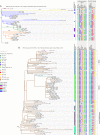Genomic Analysis of the Emergence and Rapid Global Dissemination of the Clonal Group 258 Klebsiella pneumoniae Pandemic
- PMID: 26196384
- PMCID: PMC4510304
- DOI: 10.1371/journal.pone.0133727
Genomic Analysis of the Emergence and Rapid Global Dissemination of the Clonal Group 258 Klebsiella pneumoniae Pandemic
Abstract
Multidrug-resistant Klebsiella pneumoniae producing the KPC carbapenemase have rapidly spread throughout the world, causing severe healthcare-associated infections with limited antimicrobial treatment options. Dissemination of KPC-producing K. pneumoniae is largely attributed to expansion of a single dominant strain, ST258. In this study, we explore phylogenetic relationships and evolution within ST258 and its clonal group, CG258, using whole genome sequence analysis of 167 isolates from 20 countries collected over 17 years. Our results show a common ST258 ancestor emerged from its diverse parental clonal group around 1995 and likely acquired blaKPC prior to dissemination. Over the past two decades, ST258 has remained highly clonal despite diversity in accessory elements and divergence in the capsule polysaccharide synthesis locus. Apart from the large recombination event that gave rise to ST258, few mutations set it apart from its clonal group. However, one mutation occurs in a global transcription regulator. Characterization of outer membrane protein sequences revealed a profile in ST258 that includes a truncated OmpK35 and modified OmpK37. Our work illuminates potential genomic contributors to the pathogenic success of ST258, helps us better understand the global dissemination of this strain, and identifies genetic markers unique to ST258.
Conflict of interest statement
Figures







References
-
- Centers for Disease Control and Prevention. Antibiotic Resistance Threats in the United States, 2013 Centers for Disease Control and Prevention, 2013.
-
- Patel G, Huprikar S, Factor SH, Jenkins SG, Calfee DP. Outcomes of carbapenem-resistant Klebsiella pneumoniae infection and the impact of antimicrobial and adjunctive therapies. Infection control and hospital epidemiology: the official journal of the Society of Hospital Epidemiologists of America. 2008;29(12):1099–106. 10.1086/592412 . - DOI - PubMed
-
- Yigit H, Queenan AM, Anderson GJ, Domenech-Sanchez A, Biddle JW, Steward CD, et al. Novel carbapenem-hydrolyzing beta-lactamase, KPC-1, from a carbapenem-resistant strain of Klebsiella pneumoniae. Antimicrob Agents Chemother. 2001;45(4):1151–61. Epub 2001/03/21. 10.1128/AAC.45.4.1151-1161.2001 - DOI - PMC - PubMed
Publication types
MeSH terms
Substances
Grants and funding
LinkOut - more resources
Full Text Sources
Other Literature Sources
Medical
Miscellaneous

